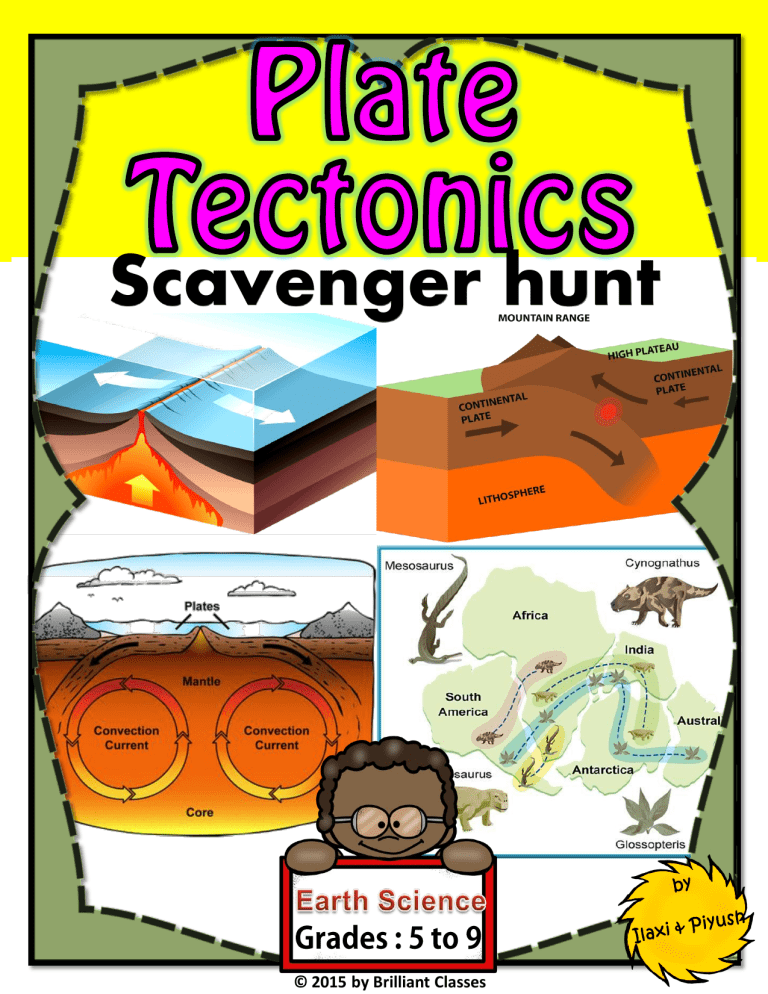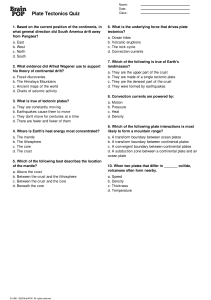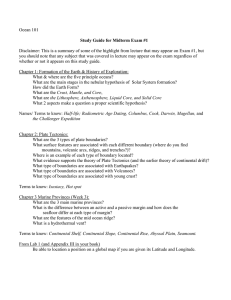
Scavenger hunt © 2015 by Brilliant Classes © 2015 by Brilliant Classes Directions to use: Plate Tectonics Scavenger Hunt Activity Purpose : At the end of this Scavenger hunt students will be able to 1. 2. 3. 4. learn about the science of plate tectonics with different theories, types of boundaries and effects of it on earth along with its vocabulary. Print the 24 Scavenger Hunt cards on card stock or brightly -colored paper and cut them apart along the black lines. Make copies of the Scavenger Hunt questions worksheet. Each student needs a copy. Place the Scavenger Hunt cards around your classroom where students will be able to find them. You can put them on chairs, on the computer keyboard, on the back of your classroom door, on the sides of student desks, on the chalkboard or wherever you like. Students have to search the room and find all of the sentence cards to answer the questions. You can differentiate by having students work alone or with a classmate. Management tips: 1. You may want to make this a silent activity so students don't share answers with each other. 2. You can have the kids work alone or with a classmate. 3. Don't be afraid to hide the facts in tough places. Kids think it's more fun when they have to search around a little. 4. Have a plan for students who finish early. You may want to have an assignment for them to complete when they're done or you may have them help other students find fact cards. © 2015 by Brilliant Classes Fact Card #1 Fact Card #2 Plate tectonics is the theory that explains that Earth's outer shell is divided into several plates that glide/move over the mantle. It studies earthquakes, how mountains are formed, and other surface features of our lovely planet. Lithosphere: The strong and rigid outer part of the earth, consisting of the crust and upper mantle is called lithosphere. Lithosphere (Crust and upper most mantle) Tectonic plate mantle Fact Card #3 Fact Card #4 Earth can be divided into three main layers: 1. Core 2. Mantle and 3.Crust Each layer of the Earth can be further divided into two parts: Oceanic crust Continental crust Lithosphere Asthenosphere Upper mentle Lower mentle Outer core Inner core Crust Mantle Core Oceanic crust Upper mantle Outer core Continental crust Lower mantle Inner core © 2015 by Brilliant Classes Fact Card #5 Fact Card #6 There are two types of tectonics plates (or crust): 1. Oceanic: It is found under the sea. It is thin and denser than the continental crust and made up of basalt. 2. Continental : It is thick and less dense than oceanic crust and made of lighter rock such as granites. Lithosphere The seven major plates include the African, Antarctic, Eurasian, North American, South American, India-Australian, and the Pacific plates. Some of the minor plates include the Arabian, Caribbean, Nazca and Scotia plates. Lithosphere Oceanic and Continental crust Fact Card #7 Fact Card #8 Convection Currents are caused by heat in Earth’s interior. It is a driving mechanism for plate tectonics. It makes the plates of lithosphere in mantle to move. Trench Lithosphere Trench 1.Lithosphere is pushed up and melted above rising convection currents. 2.Lithosphere is pulled downward above sinking currents Convection. Outer core Inner core © 2015 by Brilliant Classes Fact Card #9 Fact Card #10 Earthquakes and volcanoes are primarily found at plate boundaries. The relative movement of the plates typically ranges from zero to 100 mm annually. Fact Card #11 Fact Card #12 Plate tectonics affects humans in several important ways. 1. It causes earthquakes, and volcanism 2. It induces recycling of elements within the biosphere and between the geosphere and biosphere 3. It causes mountain-building Mountain building There are three main types of plate boundaries: 1. Convergent Boundaries 2. Divergent Boundaries 3. Transform Boundaries Divergent © 2015 by Brilliant Classes Convergent Transform Fact Card #13 Fact Card #14 Convergent Boundaries: It is where two tectonic plates push together. It is also called as destructive boundaries Convergence leads to the sinking of heavier plate under the lighter one. Divergent Boundaries: It occurs when plates move apart from each other. Other name of this boundary is constructive plate boundary. Fact Card #15 Fact Card #16 Transform Boundaries: It occurs where plates slide past each other in opposite directions or in the same direction but at different speeds. Other name of this boundary is conservative plate boundary. Alfred Wegener was the scientist who proposed the Continental Drift Theory in 1912. © 2015 by Brilliant Classes Fact Card #17 Fact Card #18 Wegner’s idea behind continental drift theory was that the Earth's continents were once joined together, but gradually moved apart over millions of years. Pangaea is a hypothetical supercontinent that included all current land masses, believed to have been in existence before the continents broke apart. Fact Card #19 Fact Card #20 Wegener developed his idea based upon 4 different types of evidence: 1. Fit of the Continents 2. Fossil Evidence 3.Rock Type and Structural Similarities 4. Climatic Evidence Sea-floor spreading is a process where new sea-floor crust forms along a mid-ocean ridge, which causes older seafloor crust to move away from the ridge. Oceanic crust Continent Mid Ocean Ridge Lithosphere Asthenosphere © 2015 by Brilliant Classes Fact Card #21 Fact Card #22 Mid-Ocean ridge: It is a longest chain of mountain in the world and are located on the ocean floor. Mid-Atlantic ridge: An undersea mountain chain in the Atlantic ocean. Harry Hess, an American geologist, while doing the work of mapping the ocean floor, discovered the mid-ocean ridge. Fact Card #23 Fact Card #24 Supporting Evidences for Seafloor Spreading are: 1. Eruptions of molten material 2. Magnetic stripes in the rock of the ocean floor 3.The ages of the rocks themselves. Subduction: It is a process at the convergent boundaries of tectonic plates where one plate moves under another and is forced or sinks due to gravity into the mantle. Regions where this process occurs are known as subduction zones. © 2015 by Brilliant Classes Name: ____________________________________ Questions Worksheet Fact Card#1: What does the theory of plate tectonics state? ________________________________________________________ ________________________________________________________ Fact Card#2: What is lithosphere? ________________________________________________________ ________________________________________________________ Fact Card #3: What are the main three layers of the earth? ________________________________________________________ ________________________________________________________ Fact Card #4: What are the different parts of main layers of the earth? ________________________________________________________ ________________________________________________________ Fact Card #5: Describe two types of tectonic plates. ________________________________________________________ ________________________________________________________ Fact Card #6: List the major and minor plates on Earth. ________________________________________________________ ________________________________________________________ Fact Card#7: What is the driving mechanism of plate tectonics? What is the cause of it? ________________________________________________________ ________________________________________________________ ________________________________________________________ © 2015 by Brilliant Classes Name: ____________________________________ Questions Worksheet Fact Card #8: How does lithosphere move due to convection currents? ________________________________________________________ ________________________________________________________ Fact Card #9: Where do volcanoes and earthquakes happen? ________________________________________________________ ________________________________________________________ Fact Card #10: How many millimeters do the tectonic plates move every year? ________________________________________________________ ________________________________________________________ Fact Card #11: What are the effects of plate tectonics on Earth? ________________________________________________________ ________________________________________________________ Fact Card #12: What are the 3 types of plate boundaries? ________________________________________________________ ________________________________________________________ Fact Card #13: Define destructive boundary. ________________________________________________________ ________________________________________________________ Fact Card #14: How is the divergent boundary formed? What is the other name of this boundary? ________________________________________________________ ________________________________________________________ © 2015 by Brilliant Classes Name: ____________________________________ Questions Worksheet Fact Card #15: How does the transform boundary work? ________________________________________________________ ________________________________________________________ Fact Card #16: Who invented the continental drift theory? When? ________________________________________________________ ________________________________________________________ Fact Card #17: What was Alfred Wegener’s idea of continental drift? ________________________________________________________ ________________________________________________________ ________________________________________________________ Fact Card #18: What is the meaning of the word Pangaea? ________________________________________________________ ________________________________________________________ ________________________________________________________ Fact Card #19: What are the 4-types of evidence for continental drift? ________________________________________________________ ________________________________________________________ ________________________________________________________ ________________________________________________________ Fact Card #20: Define sea floor spreading process. ________________________________________________________ ________________________________________________________ ________________________________________________________ © 2015 by Brilliant Classes Name: ____________________________________ Questions Worksheet Fact Card #21: Define Mid-ocean ridge and Mid Atlantic ridge. ________________________________________________________ ________________________________________________________ ________________________________________________________ FactCard #22: Who discovered Mid ocean ridge? ________________________________________________________ ________________________________________________________ ________________________________________________________ Fact Card #23: List the supporting evidences of sea floor spreading. ________________________________________________________ ________________________________________________________ ________________________________________________________ Fact Card #24: What do you understand by subduction process and subduction zone? ________________________________________________________ ________________________________________________________ ________________________________________________________ ________________________________________________________ © 2015 by Brilliant Classes Thank you for downloading our Resource You are welcome to visit our store https://www.teacherspayteachers.com/Store/Brilli ant-Classes-Science-Math-Ela On Science/Maths/ELA © Brilliant Classes








